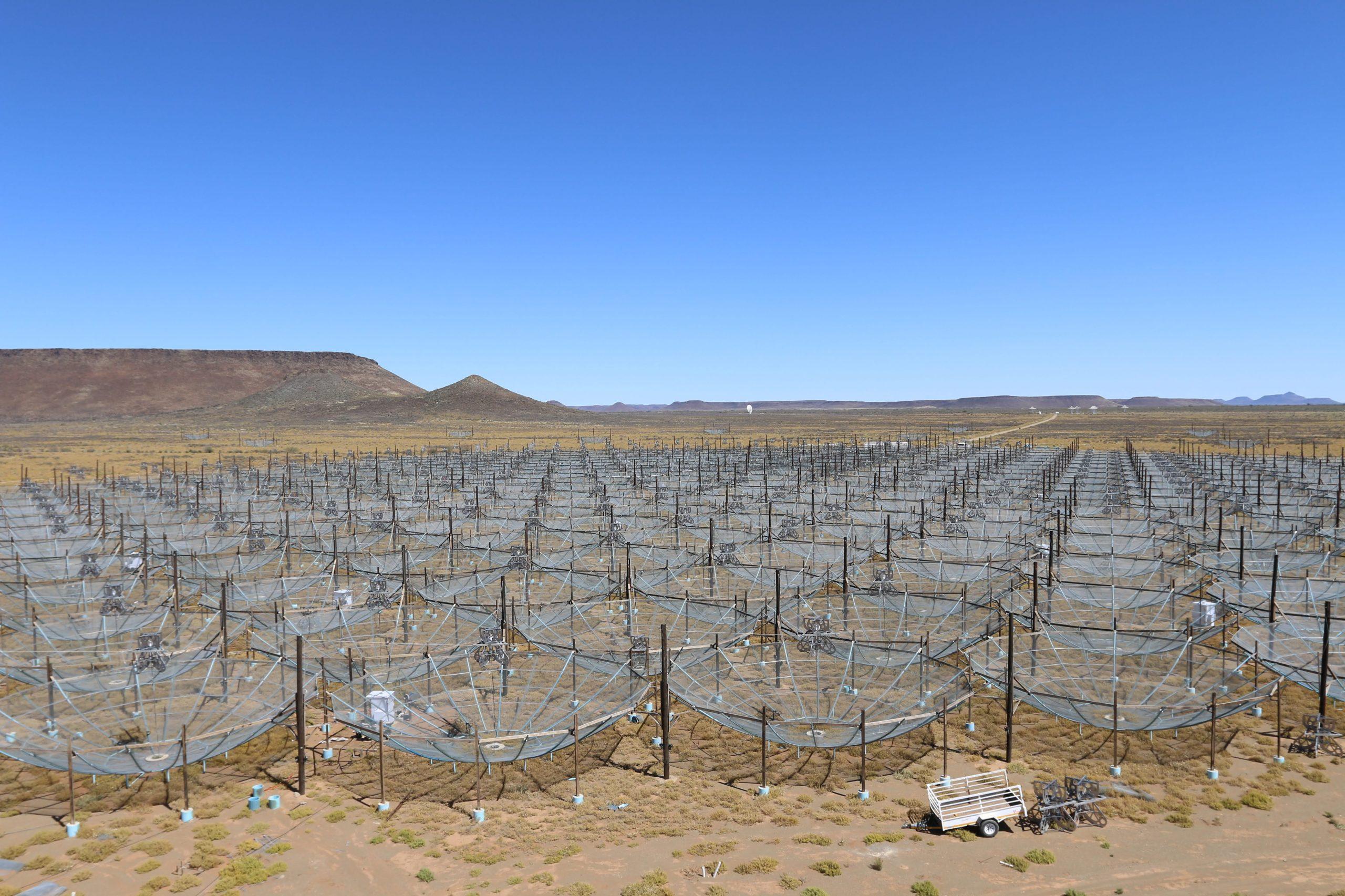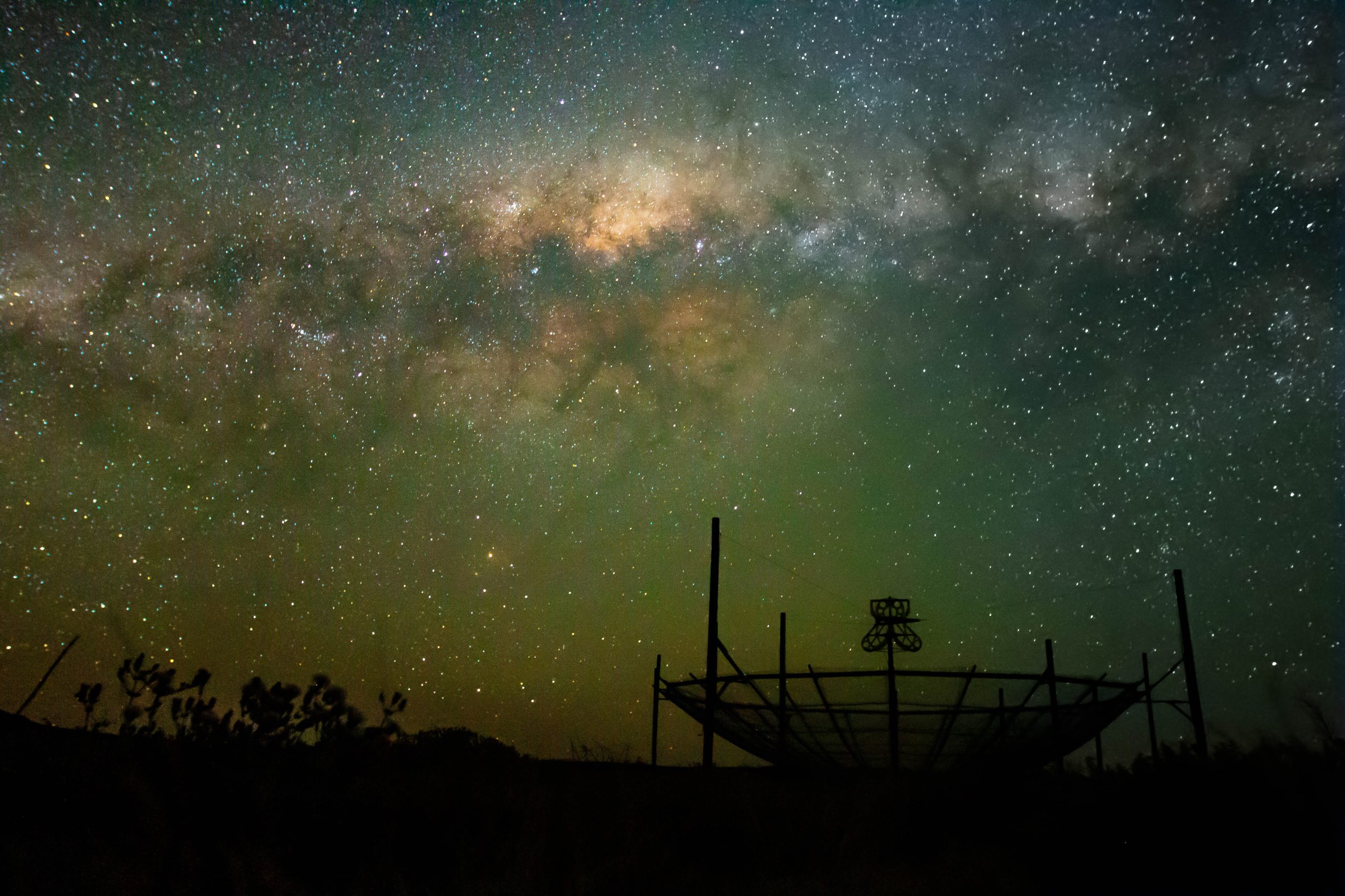
The dishes of the HERA radio telescope collect radio wave signals from the “21-centimeter line,” when hydrogen atoms in the early Universe absorbed energy from the first stars.
PSC Supercomputer Helps Set Upper Limit to “Brightness Temperature” of Hydrogen Signal, Narrowing Possible Explanations for Universe’s Evolution
When the first stars and galaxies lit, they caused hydrogen atoms in the space nearby to emit a tell-tale radio signal. This signal offers clues as to what happened in the “cosmic dark age,” from the Universe cooling down enough for atoms to form up through “first light,” when stars began to shine. Scientists of the international HERA radio telescope team used PSC’s Bridges-2 supercomputer to help them limit the possible values for a critical measurement of the hydrogen signal at two distances from Earth. Their findings narrow down possible explanations for how the Universe evolved.
WHY IT’S IMPORTANT
Immediately after the Big Bang, the Universe teemed with energy. But its soup of subatomic particles absorbed all light. As the Universe cooled, atoms of hydrogen and helium began to form. No stars yet existed.
About 150 million years after the Big Bang, the first stars began to kindle. Their light began ripping apart those atoms into positively charged nuclei and negatively charged electrons. This era, called reionization because the atomic fragments had an ionic or electrical charge, is sometimes called first light. That’s because each newborn star, and then the first galaxies of stars, slowly expanded their bubbles of ionization until, about a billion years after the Big Bang, the entire Universe had become mostly transparent.
“Reionization [is] a period of time during the first billion years after the Big Bang where the gaps between galaxies … underwent a phase transition between being neutral and ionized … One of the big questions is how we connect observations of more modern galaxies to what we are seeing at that very early time.” —Joshua Dillon, UC Berkeley
In broad strokes, that’s what we know. But cosmologists — scientists studying the formation and evolution of the Universe — want to know much more than that. They’d like to figure out which of several clever ideas, called hypotheses, scientists have come up with for how the early Universe formed and developed is true. To study that, they are using radio wave telescopes to measure what is known as the 21-centimeter line. That’s the tell-tale flash, with a wavelength of 21 centimeters, that neutral hydrogen atoms emitted long ago as they absorbed energy from the first stars.
A necessary first step in getting data that’s precise enough to test the predictions of the different hypotheses is making as accurate a measurement of the 21-centimeter line as possible. To do this, the international Hydrogen Epoch of Reionization Array (HERA) radio telescope team, led by Joshua Dillon at University of California, Berkeley (UC Berkeley), used multiple supercomputing resources. Key to the effort was PSC’s NSF-funded Bridges-2 system.
HOW PSC HELPED
One big problem is that the 21-centimeter signal of reionization doesn’t have a 21-centimeter wavelength. Not any more. Sure, when the radiation that the scientists want to measure was emitted by the hydrogen atoms, it had that wavelength. But the Universe is expanding, faster and faster with distance. Hydrogen atoms farther away are receding so fast that their 21-centimeter line is distorted. Like a train whistle getting lower and lower as it recedes, the 21-centimeter lines become lower in frequency and longer in wavelength the farther from Earth they originated. That doppler shift has made the 21-centimeter line at the distances that the cosmologists want to study more like 2 meters. The wavelength has stretched from about eight inches to six feet.
That is a huge problem, because it overlaps the FM radio band. So the investigators, if they want to “see” the 21-centimeter band, have to screen out a ton of interfering signals from both human and naturally generated radio noise. The noise, in fact, is 100,000 times as strong as the signal they need to see.
The HERA telescope array in South Africa was built to have enough sensitivity to pick out this “needle in a needlestack” signal. But when you need to filter 99,999 parts of the signal out of 100,000 to see the signal, it’s difficult to avoid filtering out what you want to detect as well. To prevent this, the HERA team carried out a series of computer simulations of the signal. By running many simulations starting from different assumptions for about 10 critical parameters, they could bracket what the real telescope array was likely to detect — and they could test their filtering software for the ability to pick out the signal.
“… our work with Bridges-2 … fell into two broad categories. One was validation — trying to simulate data that looks like our data but [in which] we fully understand what’s going on … The other is what we call parameter inference — looking at the measurements we’ve made given some hypothesis’s predictions … This required a fair amount of high performance computing … Having big systems like Bridges-2 available is very useful.” —Joshua Dillon, UC Berkeley
The team used multiple supercomputers to carry out these simulations. Bridges-2 was an important part of the work — its regular memory nodes’ ability to carry out many parallel calculations on an avalanche of data helped give them the confidence that their software wasn’t zeroing out the signal. Then, in a second round of computations, the scientists used the same array of computers to analyze the actual data being generated from their telescopes..
The collaborators’ initial findings were encouraging. They haven’t actually detected the 21-cm signal yet. But they have improved the precision of their detection between 2.1 and 2.6 times. That told them that the brightness temperature power spectrum of the 21-centimeter signal at two distances from Earth must be below certain values. This measurement, which shows what temperature a black-box would have to be to generate that frequency signal, has already ruled out a family of hypotheses for how hot the surrounding gas was when the first stars lit. This, in turn, has even in these early results begun to narrow the field of likely explanations for the Universe’s evolution. The scientists reported their results in The Astrophysical Journal in March 2023.

The HERA radiotelescope array consists of hundreds of 14-meter dishes (350, when the array is completed) sensitive to radio signals from the beginning of the Universe.
